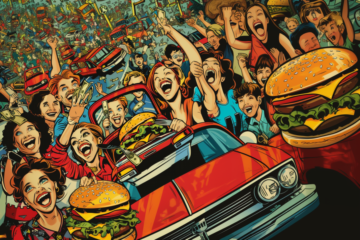The Rhythm of Gathering
The Bell at Lloyd’s
In 1696, Edward Lloyd’s Coffee House on Tower Street in London had already begun attracting sea captains and merchants involved in shipping. Lloyd, recognizing an opportunity to specialize, installed a maritime bell near the entrance of his establishment.
This wasn’t merely decorative—it had a specific purpose. Whenever a messenger arrived with news of a ship’s arrival in port, Lloyd would ring this bell loudly. The sound would carry through the neighborhood, and merchants who had cargo or insurance interests in arriving vessels would immediately abandon whatever they were doing and rush to Lloyd’s.
On one particularly noteworthy day in 1698, a fierce storm had been battering the English Channel for three days. Dozens of ships were overdue, and insurers were growing increasingly anxious. The regular patrons at Lloyd’s had been subdued, trading nervous glances over their coffee cups.
Then, shortly after noon, the bell rang with unusual vigor. Lloyd himself was ringing it with evident excitement. Within minutes, the coffee house was packed to capacity as merchants and underwriters rushed in from surrounding businesses. Lloyd had received word that fifteen ships previously feared lost had safely anchored at Plymouth.
The crowd quickly divided itself—those with interests in the safe vessels celebrated wildly, while those awaiting news of other ships pressed forward, desperate for information. Lloyd, prepared for this moment, had organized the ship reports by trade route and vessel type. He moved systematically through the crowd, connecting each merchant with precisely the information most relevant to their investments.
By evening, Lloyd’s had served more customers than any other coffee house in London that day. More importantly, it had cemented its reputation as the essential hub for shipping intelligence. The following morning, several merchants who had never previously frequented Lloyd’s arrived, asking if they might establish accounts. They had heard how efficiently information had been distributed during yesterday’s excitement.
Within two years, Lloyd began publishing a regular shipping newsletter—”Lloyd’s List”—which became so indispensable to the maritime trade that merchants would visit the coffee house solely to obtain a copy, invariably staying for coffee and conversation.
This deliberate specialization transformed Lloyd’s from a generic coffee house into an institution so vital to maritime commerce that it eventually evolved into Lloyd’s of London, the insurance market that continues to operate today, more than 300 years later.
The Strategy Behind the Bell
In 1700s London, coffee houses weren’t just places to grab a drink—they were the WiFi Hotspot of their day. Visiting a particular Coffee House was a key step in connecting to information that was needed.
Lloyd’s Coffee House was not alone in using this information strategy, others included
- Jonathan’s Coffee House was where stock traders gathered, eventually becoming the London Stock Exchange
- The Grecian attracted scientists and members of the Royal Society
- The Chapter was where publishers and booksellers conducted business
Unbeknownst to them, these merchants were implementing some key principles in restaurant marketing that are still in use today:
- Targeting Specific Customer Segments: Lloyd didn’t try to appeal to everyone—he focused specifically on the maritime segment.
- Driving Foot Traffic with Urgency: The bell created immediate urgency that physically drew people to his establishment
- Enabling access to information: Lloyd prepared information in a way that addressed individual merchant concerns
In today’s competitive landscape of running a restaurant or dining establishment, offering curated content to acquire customers is not a strategy that has legs. Information access is ubiquitous and restaurants are better served focusing on offering a quality dining experience. But we can extract some nuggets of marketing prowess from the 18th century coffee houses.
These places created recurring events that drove predictable synchronous traffic. I call it The Rhythm of Gathering.
Given that restaurants and coffee shops are natural gathering spaces with built-in infrastructure for hosting groups, you’d expect them to dominate the events landscape. Yet a real-world analysis of events offered through Eventbrite reveals a striking disconnect: only about 10% of daily events take place at restaurants or coffee shops. The majority happen at dedicated event venues, clubs, and entertainment spaces that lack the intimate, community-focused atmosphere that made Lloyd’s Coffee House legendary.
This represents a massive opportunity gap. While bars and breweries have embraced events like trivia nights and live music, most restaurants are leaving money on the table by failing to create their own ‘rhythm of gathering.’ They’re competing solely on food quality and service, ignoring the powerful revenue stream that comes from becoming a community anchor—exactly what transformed Lloyd’s from a simple coffee house into a 300-year institution.
Who’s Creating Rhythm Today
The good news is that some restaurant owners have already cracked the code. They’ve stopped thinking of events as occasional promotions and started building them into the very identity of their establishments. These aren’t elaborate productions—they’re simple, consistent gatherings that give communities a reason to show up at the same time, in the same place, month after month:
- Blue Bottle Coffee’s Producer Series (Multiple locations): This specialty coffee chain hosts regular events featuring coffee farmers and producers, creating a direct connection between consumers and producers. These events have made them a hub for sustainable agriculture discussions.
- Zingerman’s Roadhouse (Ann Arbor): This restaurant hosts “Special Dinner Series” events that focus on specific food traditions or ingredients. By establishing a regular cadence, they’ve created a community of food enthusiasts who plan their schedules around these gatherings.
- Craft & Commerce (San Diego): This restaurant established “Writer’s Block” – a monthly evening where local writers gather to work together while enjoying food and drinks. The restaurant provides power outlets, quieter music, and a special menu during these events, becoming San Diego’s unofficial hub for the writing community.
You don’t have to offer some intellectually tinted event to create a gathering. It could be a game night, chess night, open mic nights, etc. The most important things are the following:
- Identify a distinct professional community with shared interests and challenges
- Create a recurring gathering ritual with clear timing and purpose
- Facilitate valuable exchanges that couldn’t happen elsewhere
- Establish a reputation as the “home base” for that community
- Allow the community itself to evolve the tradition over time
Create your own Rhythm and ring that Bell!!!



0 Comments